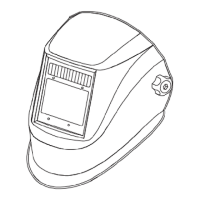OM-281997 Page 22
9-2. Troubleshooting
Trouble Remedy
Not switching – auto-
lens stays light and
does not darken when
welding.
Stop welding immediately. If power is on, review the sensitivity rec-
ommendations and adjust sensitivity. Make sure helmet is not in
Grind mode. Clean lens cover and sensors of any obstructions.
Make sure the sensors are facing the arc; angles of 45° or more
may not allow the arc light to reach the sensors.
Check batteries and verify they are in good condition and installed
properly. Also, check battery surfaces and contacts, and clean if
necessary. Check batteries for proper contact and gently adjust con-
tact points if necessary. This is particularly important if the helmet
has been dropped.
Not Switching – auto-
lens stays dark after the
arc is extinguished, or
the auto-lens stays dark
when no arc is present.
Fine-tune the sensitivity setting by making small adjustments to the
control by turning it toward the LO setting. In extreme light condi-
tions, it may be necessary to reduce the surrounding light levels.
Sections of the auto-
lens are not going dark,
distinct lines separate
the light and dark areas.
Stop welding immediately: The auto-lens may be cracked which can
be caused by the impact of dropping the helmet. Weld spatter on the
auto lens may also cause cracking. (The lens may need to be re-
placed; most cracked lenses are not covered by warranty).
Switching or Flickering
– the auto-lens darkens
then lightens while the
welding or cutting arc is
present.
Review the sensitivity setting recommendations and increase the
sensitivity if possible. Be sure the arc sensors are not being blocked
from direct access to the arc light.
Check the lens cover for dirt and spatter that may be blocking the
arc sensors. Increasing Lens Delay slightly may also reduce
switching.
Inconsistent or lighter
auto-lens shading in the
dark-state, noticeable
on the outside edges
and corners.
Referred to as an angle of view effect, auto-darkening lenses have
an optimum viewing angle.
The optimum viewing angle is perpendicular or 90° to the surface of
the auto-lens. When that angle of view varies in the dark-state, weld-
ers may notice slightly lighter areas at the outside edges and the
corners of the lens. This is normal and does not represent any
health or safety hazard.
This effect may also be more noticeable in applications where mag-
nifying lenses are used.

